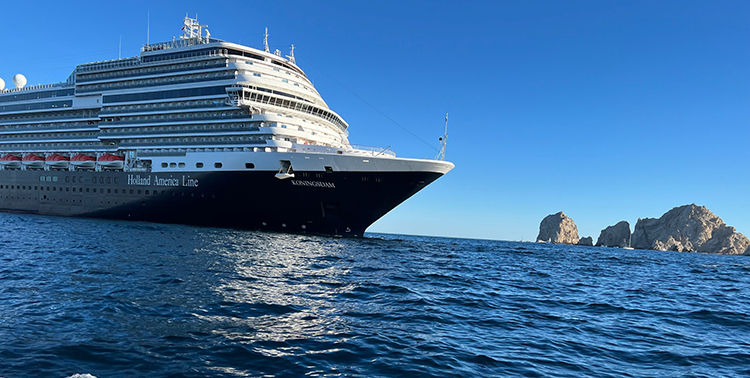
By Donald H. Harrison
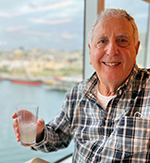
SAN DIEGO – Can Jewish stories be found aboard the 2,650-passenger, 975-foot-long MS Koningsdam, a Holland-America ship based here for a season of sailing to Mexico and Hawaii?
Yes, actually, there are several Jewish stories on the ship named for the koning, or king, of the Netherlands, Willem Alexander, that country’s first male monarch since his great-great grandfather William III died in 1890. Willem-Alexander’s mother, Queen Beatrix, abdicated the throne in his favor in 2013, just as her mother, Queen Juliana, abdicated in Beatrix’s favor in 1980. In 2020, Willem-Alexander expressed regret that his great-grandmother, Queen Wilhelmina, appeared indifferent to the plight of the Jews after Nazi Germany conquered the Netherlands. “It’s something that won’t let go of me,” he said at a remembrance ceremony.
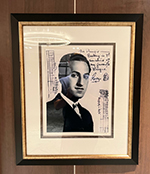
One notices almost immediately after boarding this cruise ship that it is musically themed. There are show rooms named for such musicians as B.B. King and The Rolling Stones. Four decks are named after composers Mozart, Beethoven, Schubert, and Gershwin. On the most forward of three elevator landings on Deck 5, there is an autographed photo of its namesake Jewish composer, who is well known for “An American in Paris” and “Porgy and Bess.” On the landing for the aft elevator, there is a cassette tape encased in a blue background – a physical interpretation, is it not? — of Gershwin’s celebrated “Rhapsody in Blue.”
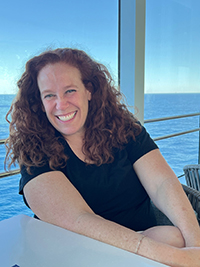
On a recent cruise, passenger Jill Gold Wright was on break from her penultimate year of rabbinical studies at the Academy for Jewish Religion California. With 25 years experience as an English professor at Mt. San Antonio College in Walnut, California, Wright is heading for a second career. She told me she couldn’t resist choosing a cabin on the Gershwin deck when she, her husband, and two children booked a roundtrip cruise from San Diego to the Mexican destinations of Cabo San Lucas, La Paz, Loreto, Mazatlan, and Puerto Vallarta. She explained that George Gershwin is one of her favorite American composers and is the subject of a chapter in her book, Creating America on Stage: How Jewish Composers & Lyricists Pioneered American Musical Theatre.
Wright graciously led two Shabbat services aboard Koningsdam during that cruise, for which Holland-America Line graciously supplied the prayer books, and wine, grape juice, challah, and gefilte fish for onegs that attracted between 15 and 20 people each Friday night. Wright chanted some traditional prayer melodies and taught the cruising congregation a few other prayer tunes as well.
Holland-America has been catering to the needs of Jewish passengers for many decades. According to its “Origin Story” slide presentation, the line was founded in 1873 and developed a good reputation among voyagers to the United States, which kept its borders open to immigrants for a little less than the next 50 years. Kosher food was offered on transatlantic voyages, with three meals a day provided even for passengers in third-class quarters, according to the scripted presentation delivered by Cruise Director Nick J. Hollevoet.
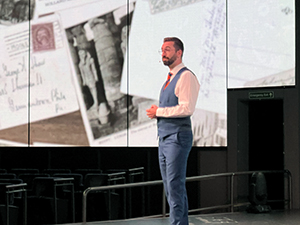
Among the immigrants who came to America on a Holland-America ship were the forebears of actor/ comedian Billy Crystal, so, Hollevoet deadpanned, perhaps the cruise line can take partial credit for such award-winning movies as When Sally Met Harry and City Slickers.
The first time that physicist Albert Einstein visited America, he did so on a Holland-America ship, Hollevoet informed us.
During the Nazi era in Germany, many Jewish refugees made their way to freedom in the United States on Holland-America ships, according to the cruise line’s official slide presentation. After Germany occupied the Netherlands, the ship was taken over by the Allied powers and converted into a troopship that ferried thousands of American servicemen to the European battlefields.
The age of the transatlantic passenger ships was ended in the 1950s with the advent of commercial jet planes that could cross the Atlantic in hours rather than days. That prompted Holland-America and other ocean liners to reinvent themselves, ushering in the current era of leisure cruises. Holland-America in association with Westours pioneered the Alaska market. Ships that repositioned between the Caribbean and Alaska sometimes utilized San Diego as a port. In 2023, Holland-America will offer 12 sailings from San Diego, more than the combined number of offerings from San Diego by Princess Cruises, Norwegian Cruise Line, and Royal Caribbean Cruise Line. In addition to Mexican destinations, Holland-America, utilizing the Zaandam, Koningsdam, and Eurodam from San Diego’s B-Street Pier, has cruises scheduled to Hawaii; through the Panama Canal to Fort Lauderdale, Florida; and to Vancouver, British Columbia.
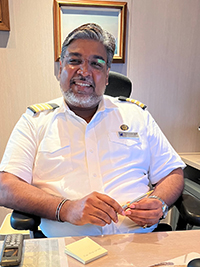
Cruises do double-duty in introducing passengers to new cultures. Of course, there is much to be learned in the countries to which they sail. There are numerous shipboard opportunities as well. According to Santhosh Nair, the ship’s Indian-born hotel manager, among Koningsdam’s 1,025 crewmembers are people from more than 100 nations. The master of the ship, Robert-Jan Kan, is from the Netherlands; Cruise Director Hollevoet is Belgian, many of the waiters and cabin stewards are from Indonesia, the bartenders tend to be Filipinos, and in one of the specialty dining rooms (the French-themed Rudi’s Sel de Mer), my wife Nancy and I chatted amiably with a German maître d’, a Zimbabwean hostess, and a Dutch waiter. Other specialty restaurants, featuring similar arrays of knowledgeable staff members, offered Pan-Asian cuisine at the Tamarind Restaurant; a la carte Japanese sushi at Nami; Italian specialties at Canaletto, and steak and seafood at the Pinnacle Grill. Over our 9-day cruise we had opportunities to sample all these enjoyable restaurants, as well as the Main Dining Room, the Lido Deck Buffet, pizza and deli on Deck 10, burgers and hot dogs by the pool on Deck 9, and pastries, tea and coffee on Deck 3’s Grand Dutch Café.
Besides at the restaurants, other activities induced passengers to mingle with people from other nations and to learn about other cultures. Tai chi exercise was offered in the mornings, as was an introductory course in Spanish. Crew members taught origami. Mahjong, a game of Chinese origin that became a favorite of Jewish women’s clubs in the 1940s and 1950s, was played in the afternoon. One afternoon’s trivia contest focused on Europe, and a lecture-at-sea related the life of radio inventor Guglielmo Marconi. In keeping with the ship’s musical theme, music of the British Isles sandwiched masterworks by the German composer Robert Schumann.
On this particular cruise, Koningsdam stopped at five Mexican ports. I chose independent activities in the first three ports – Cabo San Lucas, La Paz, and Loreto – where I pursued my interest in religion and its institutions. Specifically, my wife Nancy and I visited a Jewish center in Cabo San Lucas, arriving in time for a Saturday morning Shabbat service followed by a copious kiddush luncheon hosted by Rabbi Benny Hershkowitz and his wife Sonia. At another Chabad Center in La Paz, I met and schmoozed with Rabbi Yosef Gutierrez. In Loreto, I visited the 1697 Catholic mission that was founded by Jesuits, and later turned over to Franciscans. It was from here in 1769 that the Spanish soldier Gaspar de Portola began his exploration of what would become three Californias—Baja California Sur, Baja California, and the U.S. State of California. Called an expedition of the sword and the cross, because it was co-led by missionaries, Portola helped Father Junipero Serra to establish missions throughout the tri-state California region, including Mission San Diego de Alcala in our hometown.
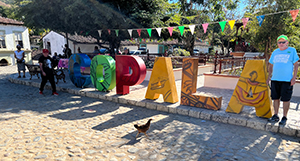
I chose to purchase land excursions offered by Holland-America both in the Mazatlan and Puerto Vallarta regions. The Mazatlan area tour took us to the towns of Malpica, Copala, and Concordia in the Sierra Madre. Along the way, we visited a bakery specializing in pan dulce (a traditional bread that is quite sweet) and also watched the process by which an artisan adds colorful designs to Mexican tiles. We visited a potter whose hand-lettered sign in English explained, “this is a workshop where some pieces of clay are made by hand and others with the help of molds, allowed to dry for a week and then baked with wood over for 4 hours.” We studied murals depicting the colonization and revolutions of Mexico, with due attention to such national heroes as Benito Juarez and Emiliano Zapata. We were served a Mexican lunch with beef or chicken our choice of entrée.

Following the tour, a Mexican buffet was served – tacos, beans, chicken, beef, vegetables, with as much beer (Pacifico) or Cola as necessary to slake our thirst. All this was a prelude to the fiesta at which four slender men and women performed folkloric dances, a charro danced in and out of his lariat, and a horse and rider danced in time to a traditional Mexican melody. Then visitors were invited to participate in a pair of contests. One was to quickly down a shot of tequila and to then whoop in delight. The other was to make a tortilla with a machine that flattens the dough. Prizes were presented to the winners.
Two days at sea from Puerto Vallarta brought us back to San Diego, refreshed, entertained, and ready to book another cruise to some places, somewhere, in what I hope will be the not-too-distant future.
*
Donald H. Harrison is editor emeritus of San Diego Jewish World. He may be contacted via donald.harrison@sdjewishworld.com